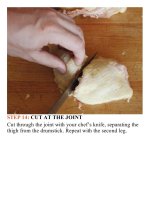The food lab better home cooking through science ( PDFDrive ) 1077
Bạn đang xem bản rút gọn của tài liệu. Xem và tải ngay bản đầy đủ của tài liệu tại đây (133.4 KB, 2 trang )
rightfully say to yourself, “Ah, I wish I had battered that
first.”
Batters are made by combining some sort of flour—
usuallywheatflour,thoughcornstarchandriceflourarenot
uncommon—with a liquid and optional leavening or
bindingingredientslikeeggsandbakingpowder.Theycoat
foodsinathick,goopylayer.Breadingsconsistofmultiple
layers.Generallyasinglelayerofflourisapplieddirectlyto
the food to ensure that its surface is dry and rough so that
the second layer—the liquid binder—will adhere properly.
That layer generally consists of beaten eggs or a dairy
productofsomekind.Thelastlayergivesthefoodtexture.
It can consist of a plain ground grain (like the flour or
cornmeal in a traditional fried chicken breading), ground
nuts, or any number of dry ground bread or bread-like
products such as bread crumbs, crackers, or breakfast
cereals.
No matter how your breading or batter is constructed, it
serves the same function: adding a layer of “stuff” around
theitembeingfriedmeanstheoilhasatoughtimecoming
indirectcontactwithit,andthushasahardtimetransferring
energytoit.Alltheenergybeingtransferredtothefoodhas
to go through the medium of a thick air-pocket-filled
coating. Just as the air-filled insulation in your house helps
mitigate the effects of harsh external conditions on the air
temperature inside, so do batters and breadings help the
food underneath cook more gently and evenly, rather than
burning or becoming desiccated by the fiercely energetic
oil.
Of course, while the food inside is gently cooking, the
precise opposite is happening to the batter or breading: it’s
drying out and its structure is getting firmer and firmer.
Fryingisessentiallyadryingprocess.Battersandbreadings
are formulated to dry out in a particularly graceful way.
Rather than burning or turning leathery, a nice airy batter
formsadelicatelycrisp,air-filledwebofteeny-tinybubbles
—a solid foam that provides substance and crunch.
Breadings work similarly, though rather than foamy in
structure,they’recraggy.Thenooksandcranniesinagood
bread-crumb coating vastly increase the surface area of the
food being fried, giving you more crunch in each bite. In
theidealworld,abatterorbreadingbecomesperfectlycrisp
just as the food inside—say, a slice of onion or a delicate
piece of fish—approaches the ideal level of doneness.
Achievingthisbalanceisthemarkofagoodfrycook.
Therecipesinthischapterwillcoverallofthebasictypes
of breadings and batters, as well some other forms of
breadingandbatter-freefrying.
THEPROSANDCONSOFFIVE
COMMONBREADINGSAND
BATTERS
COATING
HOWIT’S
DONE
PRO









